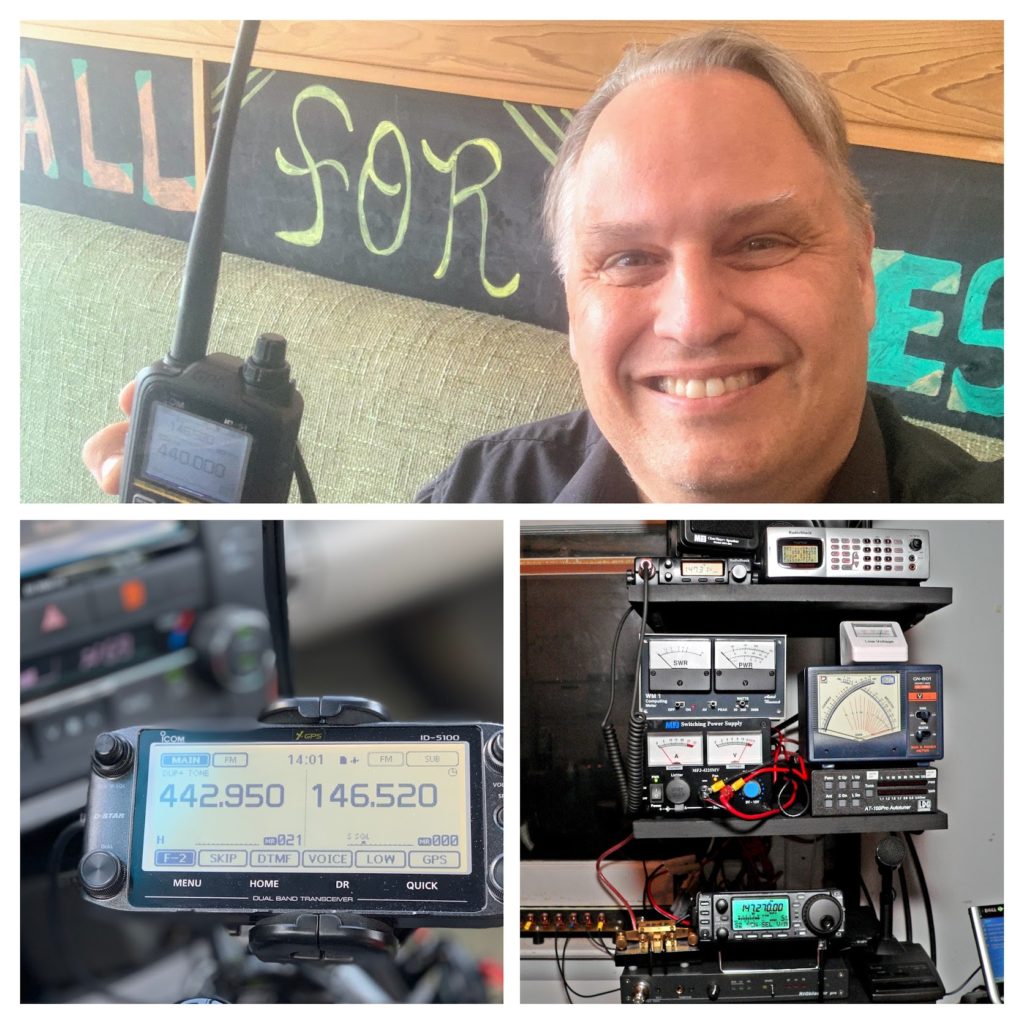Reprinted from the February 2020
Raleigh Amateur Radio Society’s EXCITER 
I’m back into Ham Radio after many years of being out and I love it even more now!
I live in Raleigh, NC where I’m self-employed with wife Barbara KI4GUM. As an only child, it fell to me to care for my parents, who lived in DC. A few years ago they peacefully passed in their home, and about that time I remembered how much I enjoyed Ham Radio. As I was driving to a family reunion near Allentown, PA with my friend who helps me drive each year, Paul Apollonia, N3GCA, who is a Ham from Philadelphia, the subject naturally came up.
We stopped in HRO to buy an ICOM ID-51A because I wanted a radio that could do digital and they said that D-Star was more active on the east coast. Then I found out that we don’t have a D-Star repeater working in this area yet (fingers crossed). Check out my video “Getting Back Into Ham Radio” http://bit.ly/backintohamradio.
When I returned to the hobby I realized I wanted to do my part to help grow Ham Radio participation in productive ways. My business keeps me extremely busy so whenever I leave the house I need to make money. I decided the best way for me to fulfill this commitment is by applying my Success Coaching and marketing skills.
I am enjoying myself immensely helping people pass their various Ham exams, expanding awareness of the hobby and encouraging constructive use of Ham Radio. Yes, in our current world, people are on their cell phones a lot and yes, there are probably a thousand ways Ham Radio is not what it “used to be,” but continuing to lament these facts won’t make any difference.
For myself, a more effective approach is to ask: “what can we each do today to promote this hobby that we love so much?” In order for Ham Radio to continue flourishing, we must make peace with the existence of social media and smartphones. Almost 3 and a half billion people now use social media, the majority of them on their smartphones, which is about 3/7th of the entire planet. Instead of complaining, I say let’s put social media to work for us by using it to collect new members and to share the value of Ham Radio.
Here are the actions I’ve taken thus far:
– My Ham Radio Youtube channel, with 200 subscribers: http://bit.ly/backintohamradio
– My Facebook page, started on Dec 8, 2019, with over 1800 likes: https://www.facebook.com/ki4cfs
– My Learning Ham Radio FB group with over 160 members (started in December) https://www.facebook.com/groups/LearningHamRadio/ and
– My website for relevant resources and content http://KI4CFS.com
You may wonder if I’m getting paid somehow for these actions, or what’s in it for me. I have multiple answers: for one, I get a personal high from the idea that I might be able to make a difference in Ham Radio on a global level. I have invested about $300 of my own money to get started, now I need to invest only my time and attention.
If I’m ever selling a product, it would be just for personal fun–I will only put it on my website – KI4CFS.com (I would never mention it on the air or put it on my other Ham Radio sites). If I am given any products to review, I will fully disclose the relationship I have with that product’s seller. I aim to keep my participation with Ham Radio pure.
My mission is the constructive global growth of Ham Radio today! If you have a similar mission I’d like you to join me.
If we don’t use it we will lose it! I know that there are a lot of great aspects to Ham Radio today that could enhance the lives of people of all ages no matter where they live. I believe that if something good happens in Ham Radio and you don’t share it online then you are acting as if nothing good happened. I also believe that if you listen without at least sharing your call sign then you are robbing us all of your company and if you don’t talk, your wisdom, plus you are robbing yourself of the benefits of connecting with others.
It is our responsibility to let the world know what is fun, useful and beneficial about Ham Radio; it is not the world’s responsibility to discover it on its own. If you don’t hear anyone on the airways that is because YOU are not speaking. Please at least try to put out a long and clear call mentioning the frequency.
Want to help me directly? Offer to let me interview you on some educational topics for the Youtube channel. Visit my web pages and like, share or comment there. Share any relevant content you think has value.
For those of you who find yourselves talking about how it used to be, cut it out! Instead, ask yourself what you can do today to support this great hobby. Keep taking action in a positive direction. One more update, I just passed my Extra exam. That was hard.
You may enjoy my article, “What Can I Do to Grow the Ham Radio Hobby?” http://bit.ly/growhamradio
Thanks to Raleigh Amateur Radio Society’s EXCITER for publishing my article and learn more about RARS at https://www.rars.org/ and if you are in the area make sure to come to their Ham Fest (RARAfest) in April
https://www.rarsfest.org/
Martin Brossman
KI4CFS, 73









